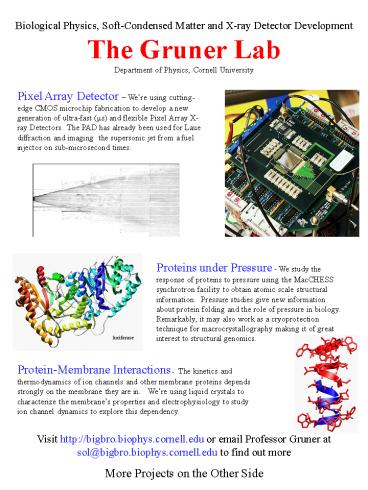Pixel Array Detector - PowerPoint PPT Presentation
Title:
Pixel Array Detector
Description:
We make and manipulate these nanocomposite structures using Block Copolymers and study their properties with X-ray scattering and electron microscopy. – PowerPoint PPT presentation
Number of Views:36
Avg rating:3.0/5.0
Title: Pixel Array Detector
1
Biological Physics, Soft-Condensed Matter and
X-ray Detector Development The Gruner
Lab Department of Physics, Cornell University
Pixel Array Detector Were using cutting-edge
CMOS microchip fabrication to develop a new
generation of ultra-fast (µs) and flexible Pixel
Array X-ray Detectors. The PAD has already been
used for Laue diffraction and imaging the
supersonic jet from a fuel injector on
sub-microsecond times.
Proteins under Pressure - We study the response
of proteins to pressure using the MacCHESS
synchrotron facility to obtain atomic scale
structural information. Pressure studies give
new information about protein folding and the
role of pressure in biology. Remarkably, it may
also work as a cryoprotection technique for
macrocrystallography making it of great interest
to structural genomics.
Protein-Membrane Interactions - The kinetics and
thermodynamics of ion channels and other membrane
proteins depends strongly on the membrane they
are in. Were using liquid crystals to
characterize the membranes properties and
electrophysiology to study ion channel dynamics
to explore this dependency.
Visit http//bigbro.biophys.cornell.edu or email
Professor Gruner at sol_at_bigbro.biophys.cornell.edu
to find out more More Projects on the Other Side
2
Biological Physics, Soft-Condensed Matter and
X-ray Detector Development The Gruner
Lab Department of Physics, Cornell University
Nanocomposite Self-Assembling Materials Polymers
can be made to spontaneously form into
complicated lattices that should have
applications including catalytic films and
photonic crystals. We make and manipulate these
nanocomposite structures using Block Copolymers
and study their properties with X-ray scattering
and electron microscopy.
CHESS Professor Sol Gruner is director of the
Cornell High Energy Synchrotron Source, a world
class X-ray facility located on campus in Ithaca.
Group members regularly perform experiments at
CHESS and projects are available in
Instrumentation, Materials Science, X-ray Physics
and Accelerator Physics. In addition, plans are
afoot for the Energy Recovery Linac, a
revolutionary new type of X-ray light source.
Membrane Protein Crystallization Over 25 of the
genome codes for membrane proteins yet only a
handful of membrane protein structures are known
to atomic resolution. It is excruciatingly
difficult to make membrane protein crystals but a
new technique was recently discovered that uses
cubic lipid phases. We are investigating how the
cubic crystallization method works and attempting
to extend it to thermotropic phase transitions
Visit http//bigbro.biophys.cornell.edu or email
Professor Gruner at sol_at_bigbro.biophys.cornell.edu
to find out more More Projects on the Other Side































